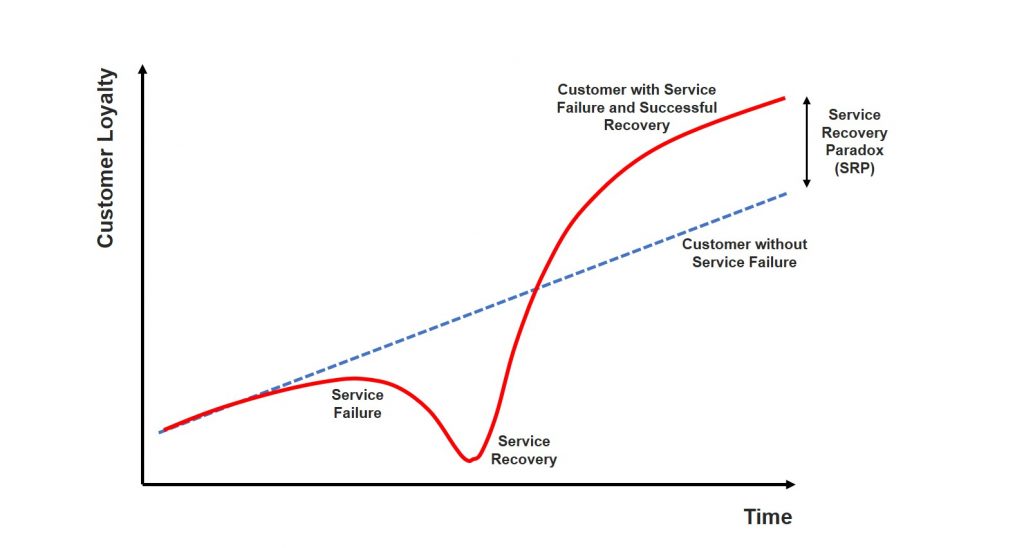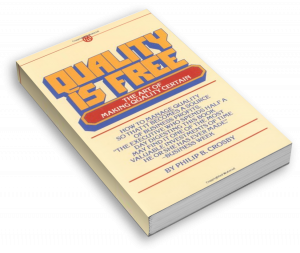Customer centricity is all about doing the right thing for the customer. Doing the right thing also means doing things right. That means service needs to be excellent. All of the time.
Sounds expensive?
Actually, it’s not. The main message in my last blog about the Service Recovery Paradox was that quality is free so make sure to build quality in from the start so you do things right first time.
The Service Recovery Paradox
By the way, the Service Recovery Paradox is a well-known management concept. It states that a service failure followed by a good service recovery can lead to more loyal customers.
The only problem is that there is no compelling evidence to show that the paradox is true. In fact, the opposite is the case.
Loyalty and Repurchase Intentions do not return to a higher level after recovering well from a service failure. There is evidence to show that Satisfaction levels can end up higher than ever before if the service recovery is managed well, but customers are less likely to repurchase.
Our own experience is that this is particularly true where there are repeated service failures. Quite often, repeated failures are symptomatic of underlying issues that have never been adequately addressed. That’s why the service fails, and fails again and again.
The implications are profound. If you want to retain clients and increase revenues and profitability, you simply cannot afford repeated service failures. The good news is that service excellence is achievable for all companies. The even better news is it doesn’t cost anything but it does mean that you need to have a good quality system in place to identify, eliminate and prevent further service failures.
Quality is Really Free?
‘Quality is Free’ and ‘Right First Time’ are references to a 1979 book by Philip Crosby. Crosby was one of the founding fathers of the Total Quality Management (TQM) movement in the 1960s and 1970s. He had previously been a senior executive and Quality Director with the US manufacturing company ITT. In the early chapters of Quality Is Free he outlines the impact of the quality programme at ITT which at the time employed 350,000 people across the globe.
Crosby’s philosophy was a simple one. Rework is very expensive. It is less expensive to do it right the first time than it is to pay for rework and repairs. So focus on doing it right first time.
Much of Crosby’s work was for manufacturing companies but the principles are exactly the same for services firms. And probably more relevant. Crosby believed that manufacturing companies wasted about 20% of revenues fixing things that had been done wrong in the first place. According to Crosby, this figure could be as high as 35% in services firms.
Crosby’s Fourteen Steps
Crosby summarised his approach to quality in 14 steps. Even though they are over 40 years old, the steps are worth repeating here. They are as critical today to retaining customers as they were in 1979 when Crosby wrote ‘Quality is Free’:
| # | STEP | COMMENTS |
|---|---|---|
| 1 | Management Commitment | Get senior management buy-in from the beginning. Leaders – particularly the CEO – must be personally committed to the quality programme. Without this, nothing will happen. |
| 2 | Quality Improvement Team | It’s senior management’s job to assemble a team and equip them with the right tools to make the programme work. |
| 3 | Quality Measurement | What gets measured gets managed. The corollary is also true. If you don’t have a measurement system, little is achieved. |
| 4 | Cost of Quality Evaluation | Calculate the cost of poor quality. That provides the business case for investing in quality. Remember that quality is free if the investment is lower that the cost of rework. |
| 5 | Quality Awareness | It’s all very well for senior management to know the cost of quality. Everybody in the company must understand it as well. Make sure they do. |
| 6 | Corrective Action | This is where we start identifying and fixing problems – with products, processes, service levels. |
| 7 | Zero Defects Programme | Set ambitious targets for 100% quality. They may not always be achievable, but the ambition must be visible. |
| 8 | Supervisor Training | The concept of supervisors may be old but investment in training for management is not. And it’s critical. |
| 9 | Zero Defects Day | This is related to Point 7 and makes a statement that one day each year must be dedicated to ensuring that a Zero Defects ethos pervades the company. |
| 10 | Goal Setting | Crosby recommends 30-day, 60-day and 90-day goals. The emphasis is on teamwork to achieve those goals. |
| 11 | Error Cause Removal | Ask individuals to describe any problem that prevents them from performing error-free work. Fix those problems. |
| 12 | Recognition | Recognise and reward excellent performance. Crosby recommends that rewards for outstanding work should NOT be financial. |
| 13 | Quality Councils | The purpose of these councils is to bring professionals together on a regular basis so that can share stories and best practices. |
| 14 | Do it Over Again | Most programmes last about 18 months before they need to be refreshed. Senior management must sustain the focus on quality so that it becomes part of the company’s DNA. |
Customer Centricity = Service Excellence
At Deep-Insight, we help B2B companies become more customer-centric. By doing so, they will improve retention rates, revenues and profitability. Customer centricity is all about doing the right thing for the customer. A lot of Deep-Insight’s clients think that a core part of being customer-centric is being able to bring Innovation to the table for their customers. Service excellence is far more important.
Don’t get me wrong, I’m not saying that innovation should be ignored. It’s a hot topic in boardrooms these days. Even so, all of our experience suggests that if companies are failing to deliver the basics well, their customers have little interest in discussions about innovation.
You need to earn the right to talk about innovation. That’s why Service Excellence is critical. Consistently good service eliminates the day-to-day ‘noise’ that gets in the way of working with clients on exciting new and innovative ideas. Service excellence also helps improve customer retention rates. That’s the core message from the Service Delivery Paradox blog.
Invest in Service Excellence
Remember: service excellence first, innovation second. So do the right things, do them right and get them right first time.
Remember also that quality is free so there is no reason NOT to invest in a Service Excellence programme for your organisation. You know it makes sense.
Do contact us today if this blog sparks any ideas and you want to have a chat about improving retention rates, revenues, and profitability.


